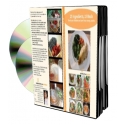How to make a tropical fruit platter
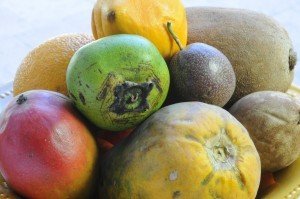 A trip to our favorite farmer's market in Homestead, Florida to Robert is Here yielded many prizes. We know it is not so warm everywhere as here so we thought we would share some tropic love and particularly to get ready for Nutrition Month - back to basics - why not develop a love of fruit and learn about new ones!?Here are the names:
A trip to our favorite farmer's market in Homestead, Florida to Robert is Here yielded many prizes. We know it is not so warm everywhere as here so we thought we would share some tropic love and particularly to get ready for Nutrition Month - back to basics - why not develop a love of fruit and learn about new ones!?Here are the names: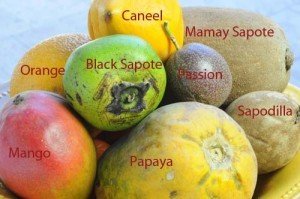 The Caneel fruit or Canistel fruit is most exquisite and easy to use. You let it sit out until it gets very soft and then you scoop it with a spoon. We decided to use an ice cream scoop to display its beautiful golden flesh in neat round balls. It tastes like an egg custard and it has a texture like velvet.The Black Sapote is equally rich in its flavor and texture. It looks and tastes like chocolate. We were quite struck with it when we sliced it in half after allowing it to soften. Look at how beautiful the color is!
The Caneel fruit or Canistel fruit is most exquisite and easy to use. You let it sit out until it gets very soft and then you scoop it with a spoon. We decided to use an ice cream scoop to display its beautiful golden flesh in neat round balls. It tastes like an egg custard and it has a texture like velvet.The Black Sapote is equally rich in its flavor and texture. It looks and tastes like chocolate. We were quite struck with it when we sliced it in half after allowing it to soften. Look at how beautiful the color is!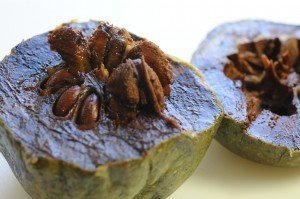 We could envision serving it with a little whipped cream and chocolate shavings but we never quite got that far because it was swooped from the platter. The texture is like avocado but the flavor has a distinct cocoa flavor.The mango is so lovely - inside and out - look at its color:
We could envision serving it with a little whipped cream and chocolate shavings but we never quite got that far because it was swooped from the platter. The texture is like avocado but the flavor has a distinct cocoa flavor.The mango is so lovely - inside and out - look at its color: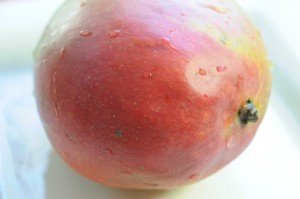 Here is part of our platter:
Here is part of our platter:
- The sapodilla is on the left front - it tastes like a sweet pear steeped in cloves. Directions: peel the skin off, remove core and cut in cubes.
- The passion fruit is so colorful and aromatic - truly exotic. Directions: cut them in half and loosened the seeds, which are the edible part.
- Next to the passion fruit you will see the black sapote (chocolate fruit). Directions: cut in half, scoop out pulp away from seeds and peel; we like to cut it in chunks like cookie dough.
- The mango is sliced and on the right. Directions: peel away the skin, slice the fruit in thin strips from the pit.
 And here is the other half of the platter:
And here is the other half of the platter:
- Apple bananas, far right. Directions: peel and quarter lengthwise. Sprinkle with Key lime juice for flavor and to keep them from turning brown.
- Ugli fruit, wedges in thecenter. Directions: remove the peel like a tangerine; separate the sections which come apart easily.
- The scooped canistel or caneel fruit is on the middle left and looks like pumpkin ice cream. Directions: cut in half and use ice cream scoop to form the soft flesh into balls.
- Mango is on the left here again.
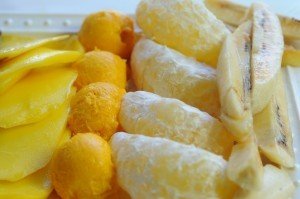 Here is the whole platter:
Here is the whole platter: The Ugli fruit was a great surprise. We have seen them in the grocery store but never paid them much attention. But it was obvious from their abundance and the reputation of Robert's that these fruits were very fresh so we had to try one.
The Ugli fruit was a great surprise. We have seen them in the grocery store but never paid them much attention. But it was obvious from their abundance and the reputation of Robert's that these fruits were very fresh so we had to try one.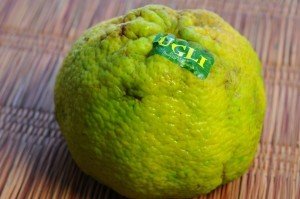 Ugli fruit tastes like lemonade candy! And look at the sections - they are large but they come apart very easily. We love these and would buy them again and again!
Ugli fruit tastes like lemonade candy! And look at the sections - they are large but they come apart very easily. We love these and would buy them again and again! Here is a photo of the Ugli fruit, the pomelo and the grapefruit just for comparison:
Here is a photo of the Ugli fruit, the pomelo and the grapefruit just for comparison: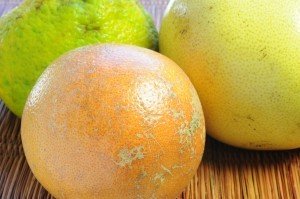 Here are the sections from the Red Indian River Grapefruit and the Pomelo - they were so sweet and juicy and this plate was gobbled for breakfast! Directions: peel the fruit, remove the core and seeds, cut into wedges - removing any more seeds that appear.
Here are the sections from the Red Indian River Grapefruit and the Pomelo - they were so sweet and juicy and this plate was gobbled for breakfast! Directions: peel the fruit, remove the core and seeds, cut into wedges - removing any more seeds that appear. This citrus plate made a lovely centerpiece and we enjoyed using these in our meals all week long:
This citrus plate made a lovely centerpiece and we enjoyed using these in our meals all week long: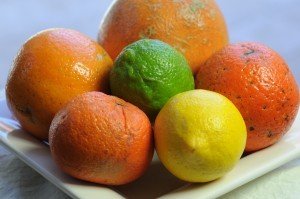 The orange platter kept in the refrigerator and these were wedged and peeled for dessert and lunchboxes:
The orange platter kept in the refrigerator and these were wedged and peeled for dessert and lunchboxes: One good idea was to peel and wrap the tangerines so they could be "on the go" with us or ready for lunch boxes - less messy for the person eating them on the go:
One good idea was to peel and wrap the tangerines so they could be "on the go" with us or ready for lunch boxes - less messy for the person eating them on the go: The star fruit were very plentiful and their playful shape can come in handy for fruit salad or as a tart garnish for fish. I was able to snap a photo of them growing on the trees in the nearby Fruit and Spice Park in Homestead. Directions: slice them thin - no peeling needed. For more information see the guide to tropical fruit by Robert is Here.
The star fruit were very plentiful and their playful shape can come in handy for fruit salad or as a tart garnish for fish. I was able to snap a photo of them growing on the trees in the nearby Fruit and Spice Park in Homestead. Directions: slice them thin - no peeling needed. For more information see the guide to tropical fruit by Robert is Here.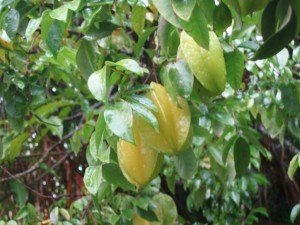 We do have more cooking instruction materials here:
We do have more cooking instruction materials here:

